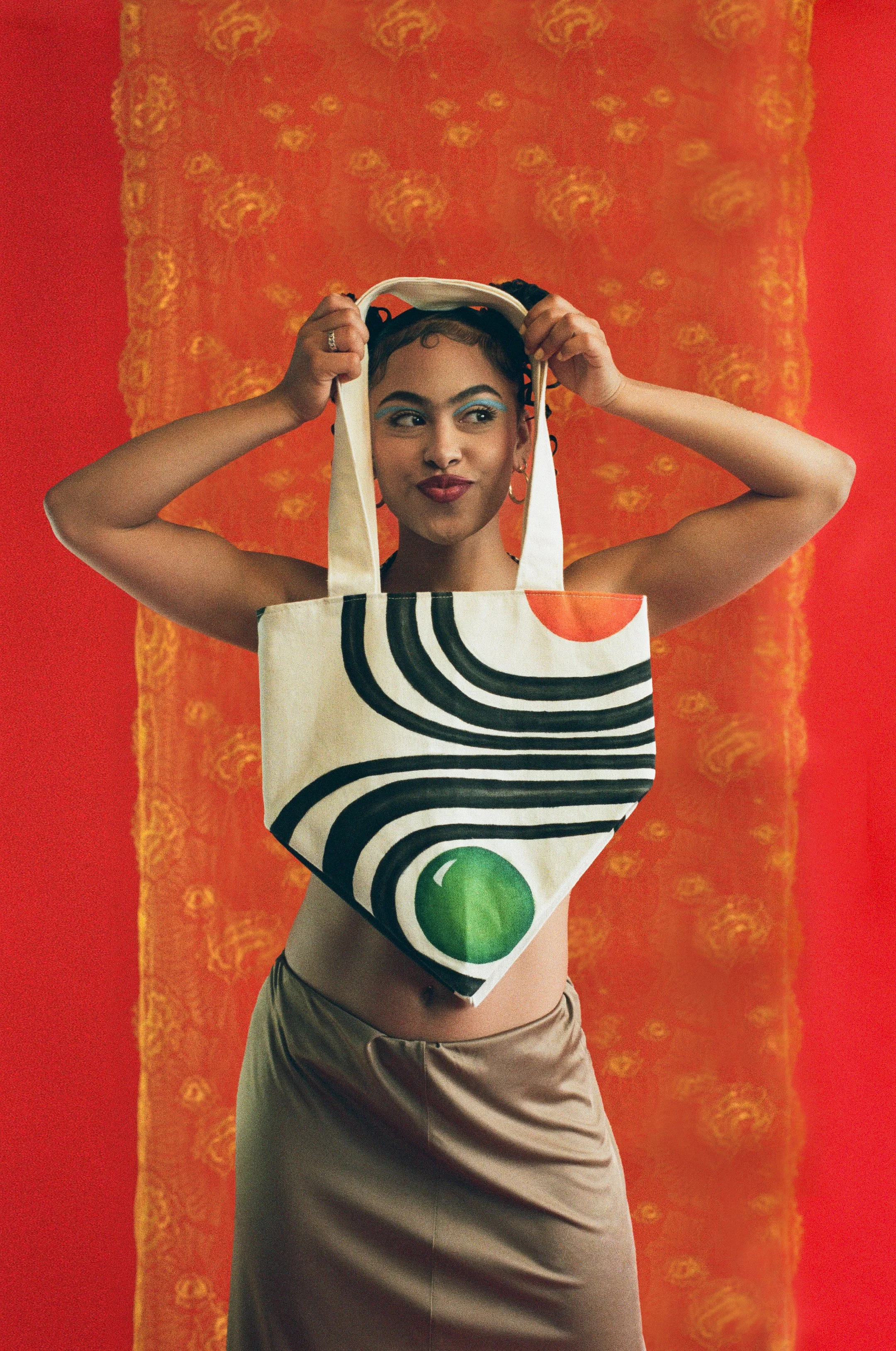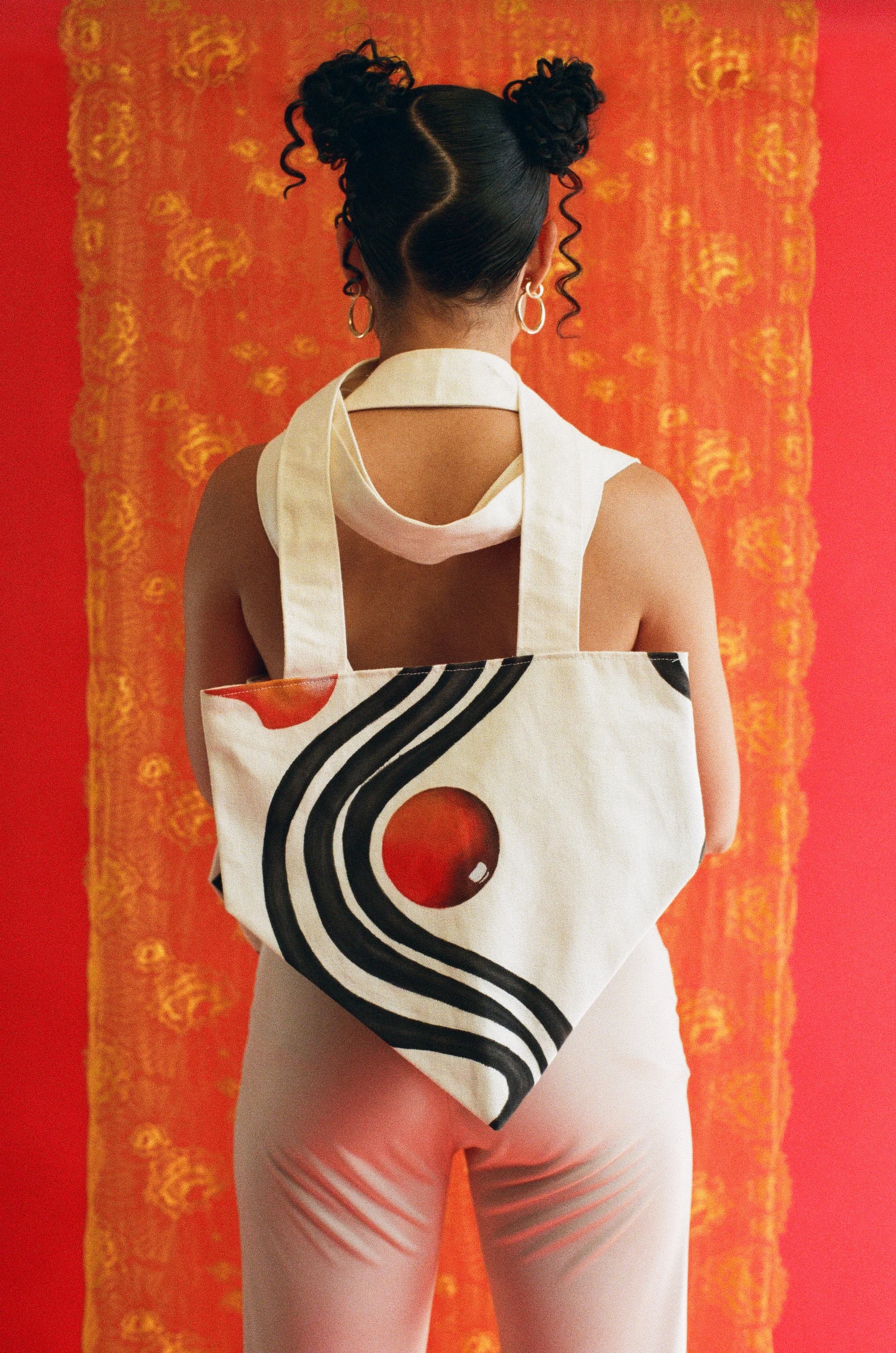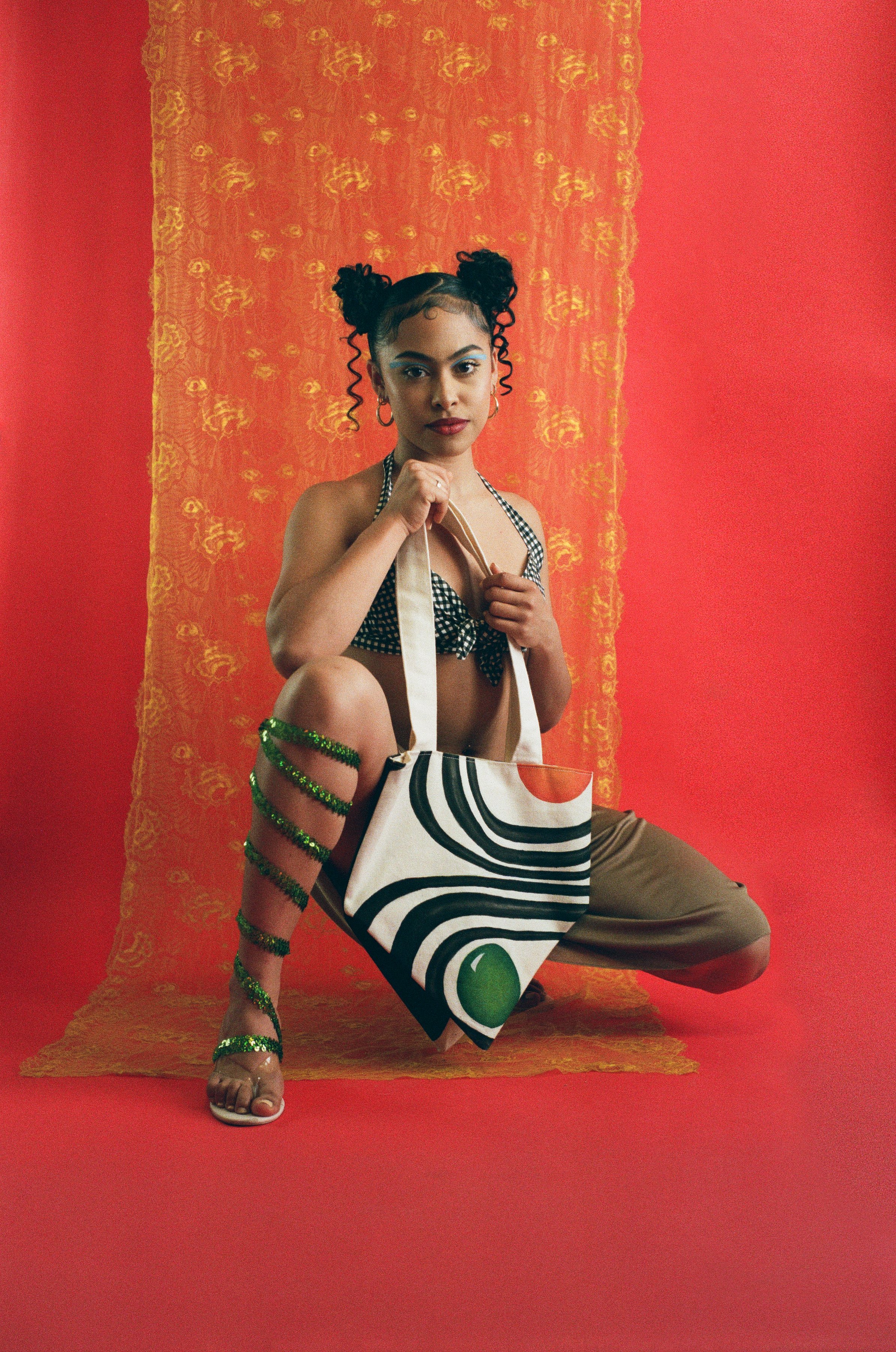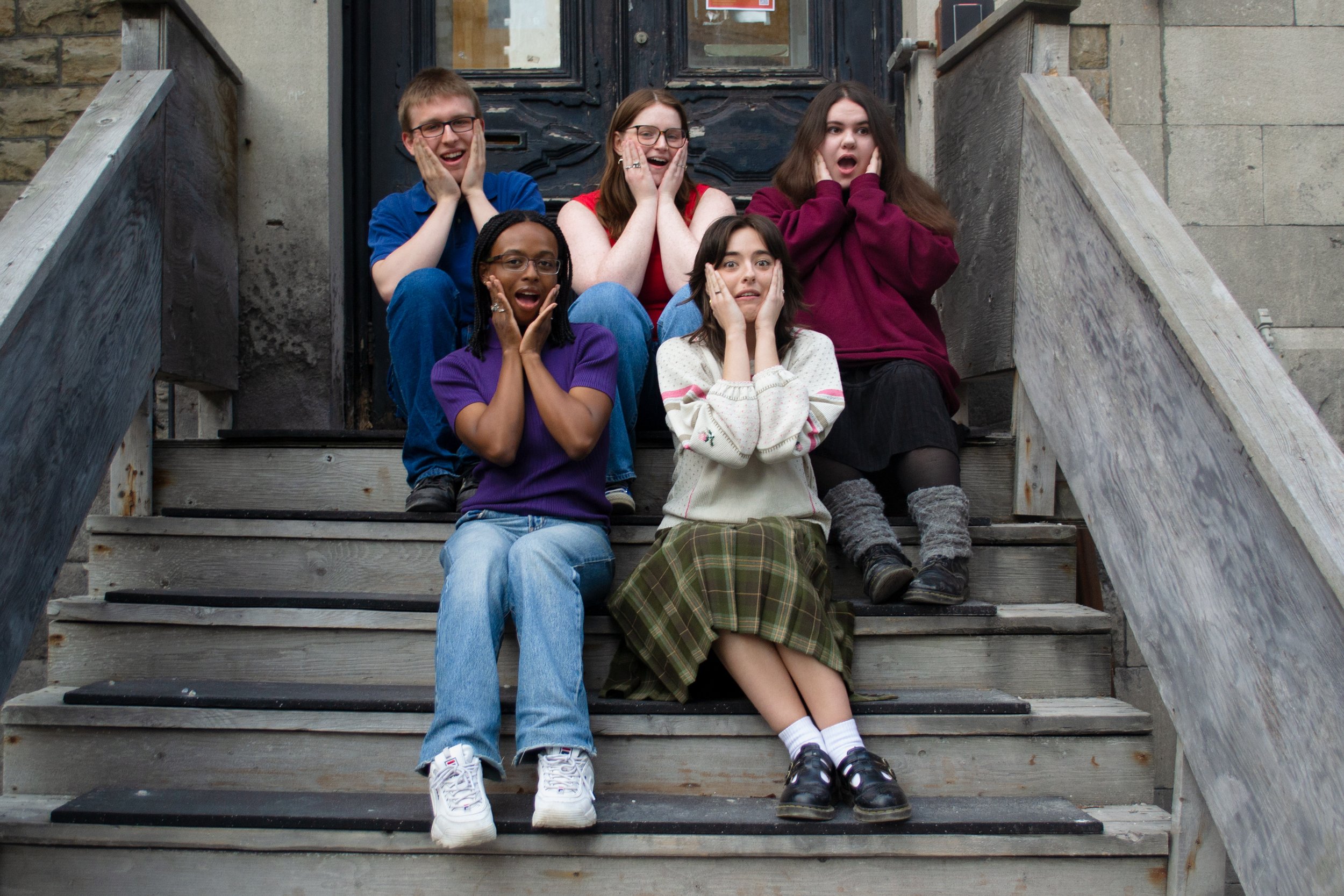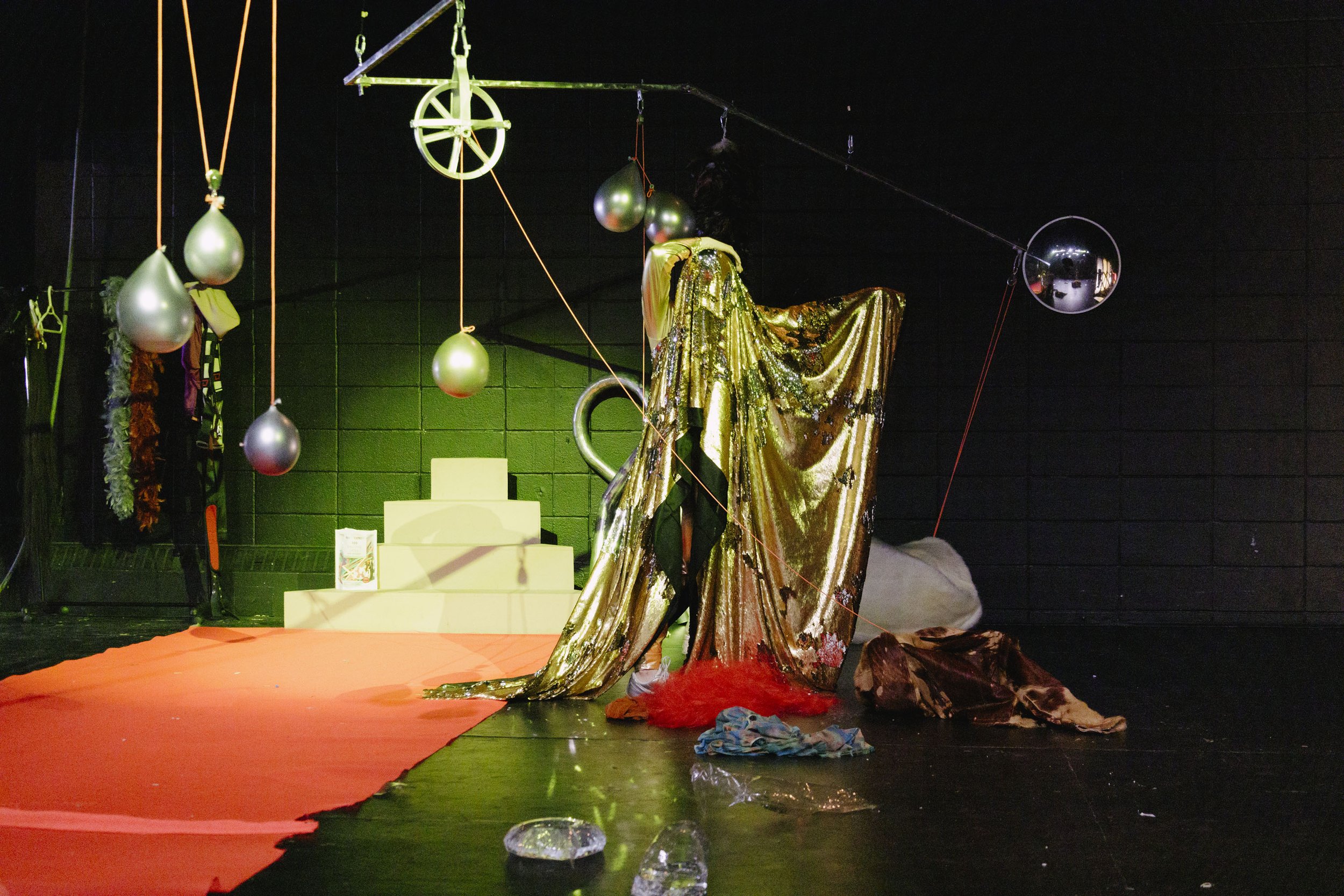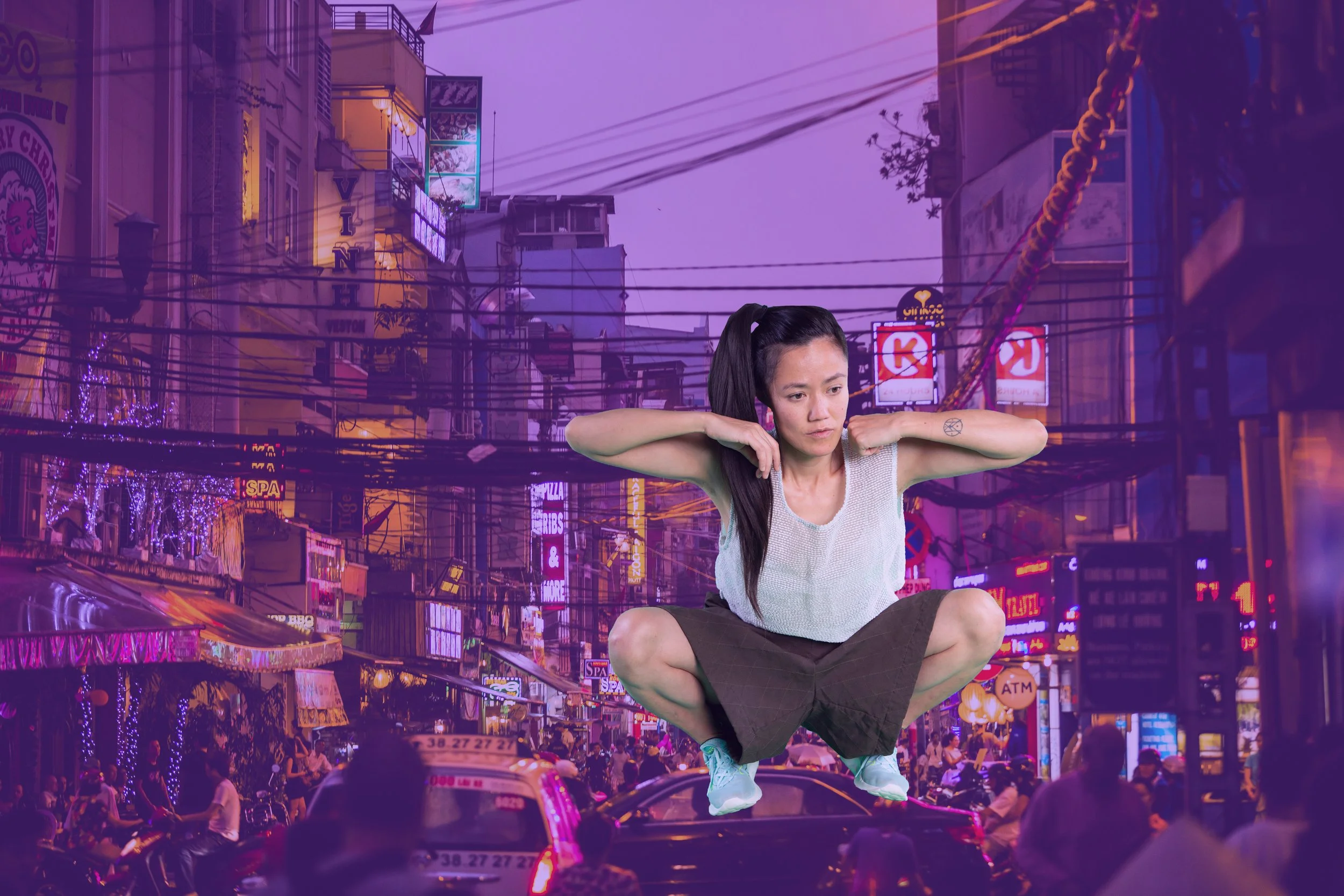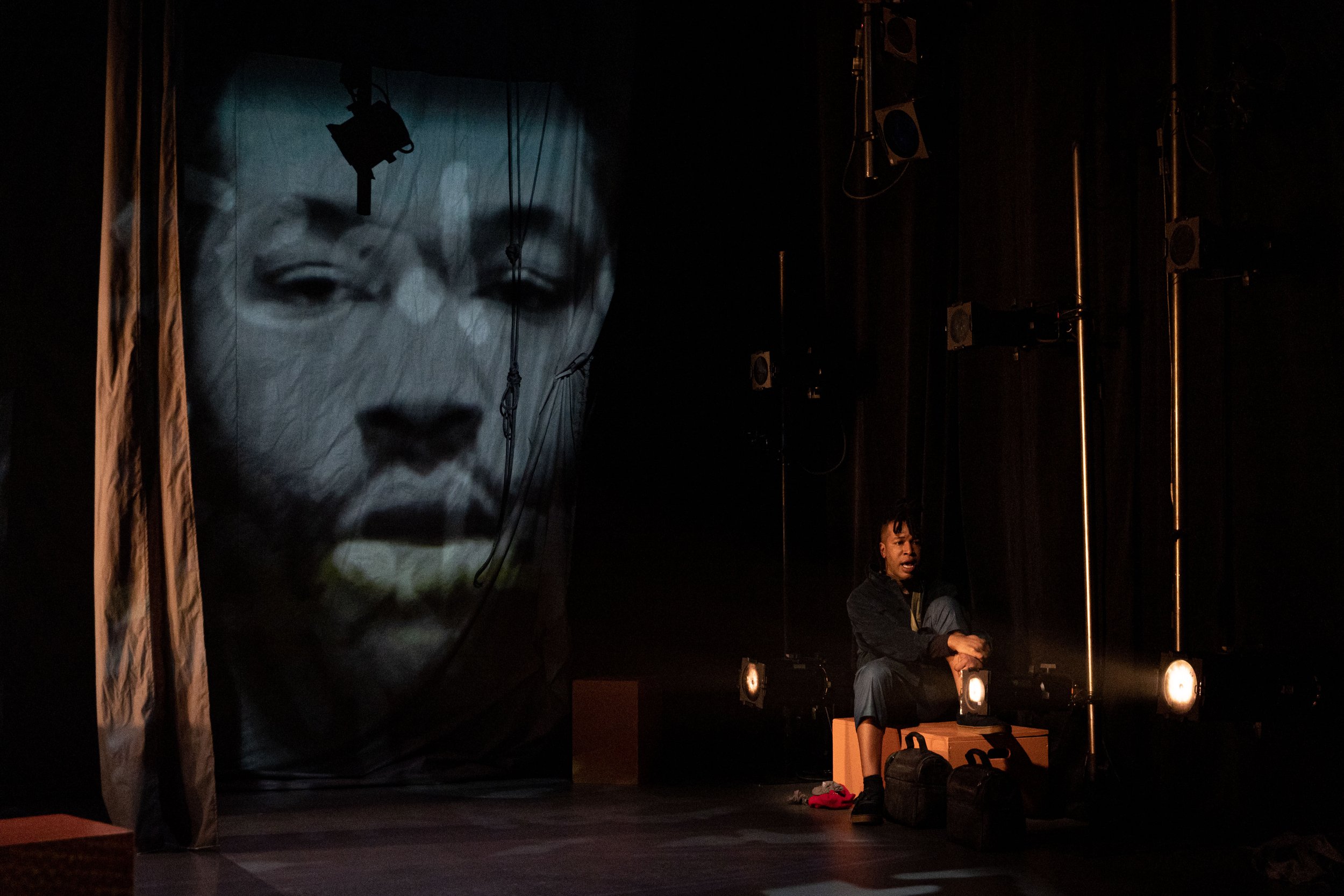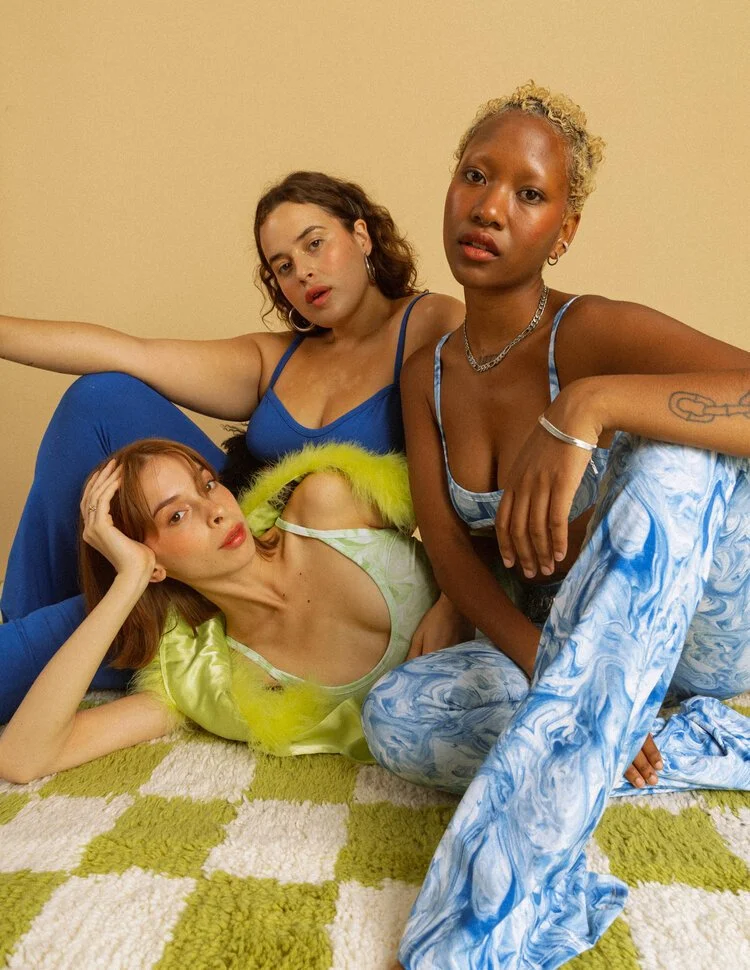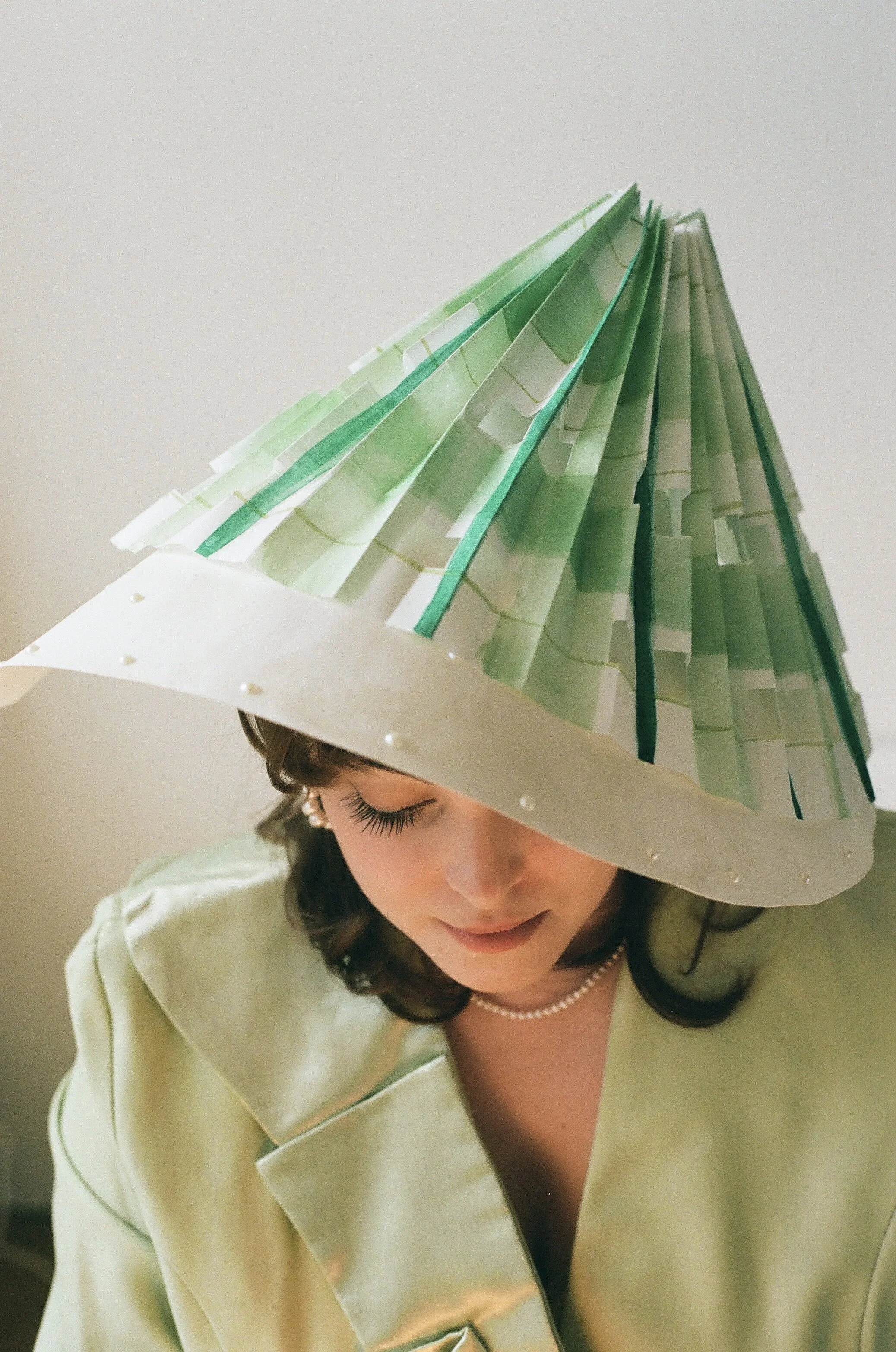La Luna Naranja: Exploring the Collaboration of Amalia Naranjo, Luna Nashar, and Oriana Confente
Amalia Naranjo modelling the La Luna Naranja collection. Photo courtesy of Oriana Confente
“Every night, I am alone. I transform into
different shapes
Every 28 days.”
As seasons begin to change, I have found myself getting further swept up by pensiveness under the night sky. The evenings draw longer, leaving a collection of charcoal clouds and twinkling stars which further illustrate the vastness that surrounds us and the bittersweet reality that everything must shift. Who are we in relation to each other, to our environment, and to past versions of ourselves?
The latest creative collaboration between Montreal-based artists Luna Nashar, Amalia Naranjo and Oriana Confente contends with such questions, linking tote-bag aficionados across the universe with a transcendent connection. La Luna Naranja was released earlier this summer; its canvas was carefully designed by Naranjo and Nashar, and captured by Confente with a warm and decadent editorial photoshoot. On La Luna Naranja, the trio shares:
“La Luna Naranja offers a unique fragment of what forms a Bigger image. In this fast-paced life, we go through ours with a small perspective of what's happening around us, letting our surroundings affect how we grow and reshape into our new self. The uniqueness of a Luna Naranja bag represents the beauty of individuality while still being a part of a more complex whole. A 1x1 metre canvas, hand painted by Amalia Naranjo. Each tote bag, unique, is a part of a greater picture. United, they create the original piece. However, the canvas was never meant to keep its beauty for itself. Cut, folded and sewn, it shares its true purpose: unity through art.”
The project alluringly melds temporality with an everlasting vibrance – what began as one has been reborn as many, and the many have been immortalized as one. Although the fragments of La Luna Naranja have each found their forever homes, their bond—much like ours with the past, present, and future—remains fused throughout the phases of the night sky. Also Cool Mag recently connected with Naranjo, Nashar, and Confente to discuss their creative bonds and their visions for La Luna Naranja.
Amalia Naranjo modelling the La Luna Naranja collection. Photo courtesy of Oriana Confente
Rebecca L. Judd for Also Cool Mag: Thank you all for sharing your creativity with Also Cool! To start, I would love to know a bit more about each of you and your respective practices. Can you elaborate on how this collaboration came about? How did you folks cross paths, and which artistic values or interests have you bonded over?
Luna Nashar: Amalia and I met on set of my first editorial in 2020, and I met Oriana at my very first art exhibition a year later! Since then, we have created opportunities for ourselves to connect and grow together as creatives.
I am inspired by Amalia’s unapologetic approach to her art. She is a multidisciplinary artist, and [through this project] I really wanted to challenge her and get to know her as a painter.
Oriana is a perfect fit on the project. Her use of film photography reinforces the “one-of-a-kind” theme of the project. I also love discussing sustainability in fashion with Oriana – we both are big on thrifting! It was interesting to have her on this project where a new art piece is recycled into a tote.
Oriana Confente: I actually met Amalia on the same night I met Luna at her exhibition last year. That was the first time I had seen Luna’s textiles and Amalia’s paintings.
It’s funny how sometimes you encounter people and you just click. Like Luna mentioned, we connected over sustainability in fashion and I admire her approach to design. I love that Luna often repurposes deadstock fabrics, and I’m obsessed with her interpretations of the female form. I mean… pussy pockets. What a concept! I have at least three at home, and I’m sure that I’ll own more soon.
I fully agree with Luna – I’m also inspired by Amalia’s unapologetic approach to her work. Getting to know her more through the events and projects that Luna organized has been lovely. It was especially fun to have an opportunity for Amalia to model with pieces she co-created. Funnily enough, this shoot was supposed to just be for e-commerce at first, but it evolved into so much more. I am thankful for transformation!
Amalia Naranjo: Like Luna said, we met in September 2020 for her editorial photoshoot. A year after that, I met Oriana at Luna’s art exhibition The Red Room. Their energy always felt so pure and real to me, when Luna proposed to me to collaborate with her on a tote bag project where I would get to paint, I was really excited to jump in.
I immediately bonded with Luna. I loved her style, her creativity and her aesthetics, but mostly her perspective on arts and community values. She has the gift of bringing interesting creative people together so we can share and collaborate on our creations. Oriana’s artistic approach on themes like nature and technology and how they can co-exist really captured my attention. I admire the complexity of her projects and how she talks about it in an effortless manner.
Also Cool: La Luna Naranja fuses individual pieces into a greater narrative about transformation, reflecting on interconnectedness between eras and experiences. Tell us more about how this is thematically reflected in the collection, and what you’ve learned in creating it.
Luna: I feel like a bond of sisterhood developed throughout the project, as we learned from each other and spent time with each other's art. It was fruitful to share and be part of different challenges when it comes to our different mediums. As I sewed the totes, I could tell where Amalia put more paint! It was really fun to imagine her creative process as I was transforming her art.
Also, it was lovely seeing people choose which tote would be theirs. It reflects their uniqueness. I feel like La Luna Naranja created a small community where each one-of-a-kind tote is carried by an exceptional soul who shares a love for the art piece. The sisterhood that we shared together is for the community.
Amalia: When I had to come up with a design, I knew I wanted to bring a sense of uniqueness to every individual bag, so I knew that it wouldn’t be a single pattern throughout the whole fabric. But I also wanted it to be all connected and dynamic to represent movement and change through time and space – hence the lines that travel through the whole piece. There are also the different shapes of what seem to be naturally-rounded balls, but whose shapes change depending on their surroundings – just like us. Humans are affected by our surroundings, and we change as we move through time and space.
Amalia Naranjo modelling the La Luna Naranja collection. Photo courtesy of Oriana Confente
AC: I’m interested in the prospect of “unity through art”; how the repurposing of this piece into tote bags helped it to achieve a higher level — “its true purpose”. As artists, was there a moment when you felt that this was achieved?
Luna: Great art is life-changing. Traditionally, a painting is appreciated in a specific space. Repurposing it into a timeless piece elongates its narrative. I love the idea that you get to spend time with a piece that makes you feel a certain way.
Transforming Amalia’s art was a very big moment for me – especially the first cut! I feel like a bond of sisterhood developed throughout that process of transformation. Although, the greatest feeling is knowing those tote bags are part of someone else’s life now. Maybe we should do a reunion with all the La Luna Naranja carriers!
Amalia: I could not say it better, Luna! By giving the art piece a utility, its purpose definitely adds more to the symbolism of moving through time and space with the user, and the sense of unity with all the people involved in this creation and the consumer is defined. I feel like this project keeps reaching higher levels. From doing a playful photoshoot, wearing the big painted fabric, to wearing the individual tote bags while doing more of a conceptual photoshoot. I feel it even more when I see people using it in their everyday lifestyle, and finally, when I see it published in a magazine for all eyes to see!
Amalia Naranjo modelling the La Luna Naranja collection. Photo courtesy of Oriana Confente
AC: I’d love to hear more about the intentions with colour in the piece, both as totes and in this photoshoot.
Luna: Each emotion that each colour communicates, I want to feel and experience. I wear what I feel, and I am very comfortable expressing those feelings. I like finding balance in those emotions and I believe Oriana did a great job capturing that!
Oriana: Luna and Amalia are both incredibly vibrant human beings, in terms of the work they create but also in terms of who they are. Capturing their essence in this editorial was important to all of us.
Amalia came to the set with electric blue eyeliner, and Luna had the spontaneous idea to throw some yellow lace she had in the studio over the backdrop… It came together quite naturally.
Amalia: I cherry-picked the colours to create a vibrant palette of a nice variety, one that represented a diverse range of feelings and states. I also had fun blending various colours inside the balls, which was again to represent free movement and transformation. I chose to paint the lines black so that they could be neutral while the balls do all the eye-catching with their bright changing colors. When it came to the photoshoot, we approached colour in the same way: we went extra on the colour palette with the electric blue eye makeup, the extravagant red backdrop and the bright yellow lace.
AC: Thank you all for your time! To close things off, what are each of you up to next, creatively? Are there any future collaborations in the works?
Luna: I am currently working on a new collection of bags in collaboration with a vintage store in Montreal, where transformation is also a major theme. Truly, collaborations are essential to every artist's growth.
Oriana: Luna and I are starting a new project together! My practice, through photography and other creative means, is interested in disrupting consumerism and repurposing materials. I work with electronic waste (e-waste) a lot. Right now, Luna and I are co-designing garments that incorporate e-waste we’re collecting from friends and family.
I’ve created e-waste accessories before—like earrings made from microchips—so it’s exciting to be working with a skilled designer like Luna to make more elaborate wearables. Plus, sharing talents and merging practices continues to commit us to transformation and unity through art. Collaboration and making-with is crucial for any type of community. I’m grateful I can experience that artistically with really cool folks.
Amalia: I am very proud to say that as La Luna Naranja sold out very quickly, I am currently working on a new collection of painted tote bags with Luna. I am also working on a collection of paintings to have my own art exhibit soon. I am looking forward to more collabs with more creatives as I believe we can only do so much more amazing stuff when we work together.
Medusa, a “pussy pocket” bag produced by Luna Nashar. Photo courtesy of Luna Nashar
La Luna Naranja
Modelled by Amalia Naranjo
Photographed by Oriana Confente
Garments produced by Luna Nashar
Tote bags designed by Luna Nashar and Amalia Naranjo
Hair styled by FirstClass Hair
Make-up by Dorianys Naranjo
Assisted by Vladim Vilain

